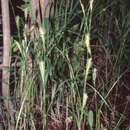Description
provided by eFloras
Culms trigonous in cross section, (25–)30–110 cm; vegetative culms hard, solid with parenchyma, taller than fertile culms. Leaves: basal sheaths reddish purple, inner bands fibrillose with age; sheaths with apex of inner band pale to dark brown, translucent between veins, strongly veined, becoming ladder-fibrillose, glabrous, veins scabrous; ligules 2–12(–17) mm; blades 3–6 mm wide, glabrous, not papillose abaxially. Inflorescences (9–)15–65 cm; spikes erect or ascending; proximal 2–4 spikes pistillate; terminal 2–5 spikes staminate. Pistillate scales lanceolate to narrowly ovate, apex acute to acuminate, scabrous-awned, otherwise glabrous. Staminate scales lanceolate to narrowly ovate, apex obtuse to acuminate, occasionally with scabrous awn, glabrous. Perigynia 12–26-veined, (4.4–)4.8–8.4 × 1.8–3.3 mm, glabrous or scabrous on veins; beak straight to slightly spreading, 1.7–3.8 mm, glabrous or sparsely scabrous-pubescent, teeth (0.8–)1.1–2.3 mm.
- license
- cc-by-nc-sa-3.0
- copyright
- Missouri Botanical Garden, 4344 Shaw Boulevard, St. Louis, MO, 63110 USA
Distribution
provided by eFloras
Man., Ont., Sask.; Ill., Iowa, Kans., Minn., Mo., Mont., Nebr., N.Dak., S.Dak., Wis.
- license
- cc-by-nc-sa-3.0
- copyright
- Missouri Botanical Garden, 4344 Shaw Boulevard, St. Louis, MO, 63110 USA
Habitat
provided by eFloras
Openings in bottomland and lowland forests, edges of marshes, lakes, and ponds, wet meadows, wet thickets, mesic to wet prairies and savannas; 140–600m.
- license
- cc-by-nc-sa-3.0
- copyright
- Missouri Botanical Garden, 4344 Shaw Boulevard, St. Louis, MO, 63110 USA
Comprehensive Description
provided by North American Flora
Carex laeviconica Dewey, Am. Jour. Sci. II. 24: 47. 1857
Carex arislata var. longo-lanceolala Dewey, Am. Jour. Sci. II. 18: 102. 1854. (Type from Nebraska
Territory.) Carex trichocarpa var. Boott, III. Carex 58. 1858. (Type from Red River.) Carex trichocarpa var. imberbis A. Gray, Man. ed. 5. 597, in part. 1867. (Not as to type.) Carex trichocarpa var. Deweyi L. H. Bailey, Bot. Gaz. 10: 293. 1885. (Based on C. laeviconica
Dewey.) Carex trichocarpa var. laeviconica Hitchc. Trans. Acad. St. Louis 5: 524. 1891. (Based on C. laeviconica Dewey.) Carex aristata subsp. trichocarpa var. laeviconica Kiikenth. in Engler, Pflanzenreich 4 ;o : 754. 1909. (Based on C. laeviconica Dewey.)
Loosely cespitose and stoloniferous, the stolons long, horizontal, slender, rather tough, scaly, the culms 3-12 dm. high, shorter than or exceeding the leaves, aphyllopodic, sharply triangular, smooth, dark-purplish-tinged at base, the basal sheaths breaking and becoming conspicuously filamentose, sterile shoots very conspicuous, very elongate, the leaves largely bunched at top; leaves with well-developed blades few to several to a fertile culm, not clustered at base, more or less septate-nodulose, the blades flat above, channeled at base, firm, dull-green, 1-5 dm. long, 2-8 mm. wide, glabrous with rough edges and more or less roughened, the sheaths dull-brown (not purplish-tinged) and deeply concave and sometimes sparsely short-pubescent at mouth, quickly breaking and becoming strongly filamentose, the ligule as long as wide; staminate spikes 2-6, the upper contiguous, the lower more or less strongly separate, rarely with a few perigynia, narrowly linear, slender, 2-5 cm. long, 3-4 mm. wide, the scales oblong-obovate, obtuse to awned, subciliate, light-yellowish-brown with lighter center and narrow dull-white margins ; pistillate spikes 2-4, widely separate, erect, sessile to more or less strongly peduncled, oblong-cylindric, 2.5-7.5 cm. long, 8-12 mm. wide, closely flowered above, sometimes more loosely at base, the perigynia 25-50, ascending in several rows; bracts leaf -like, the lowest more or less strongly sheathing, exceeding culm; scales ovate-lanceolate, acute, acuminate, or aristate, light-reddish-brown with wide 3-nerved lighter center and narrow hyaline margins, much narrower and shorter than the perigynia; perigynia broadly ovoid, 6 mm. long, 3.5 mm. wide, suborbicular in cross-section, somewhat inflated, glabrous, coriaceous, greenish-yellow or straw-colored, strongly many-ribbed, truncate at base, nearly sessile, contracted into a broad, sparingly serrulate or smooth, deeply bidentate beak half as long as the body, the teeth prominent, stiff, 1-2 mm. long, erect to spreading, scabrous within; achenes obovoid, 2.5 mm. long, 1.5 mm. wide, triangular with sides concave below and blunt angles, loosely enveloped, olive-brown, sessile or nearly so, round-tapering at apex and continuous with the straight slender style; stigmas 3, slender, long, blackish.
Typk locality: On the Big Sioux, Nebraska Territory; Dr. F. V. Hayden.
Distribution: Marshes, in calcareous districts, Manitoba to Saskatchewan and southward to Illinois, Missouri, Kansas, and Montana. (Specimens examined from Illinois, Iowa, Missouri. Kansas, Nebraska, South Dakota, North Dakota, Minnesota, Saskatchewan, Montana.)
- bibliographic citation
- Kenneth Kent Mackenzie. 1935. (POALES); CYPERACEAE; CARICEAE. North American flora. vol 18(7). New York Botanical Garden, New York, NY

